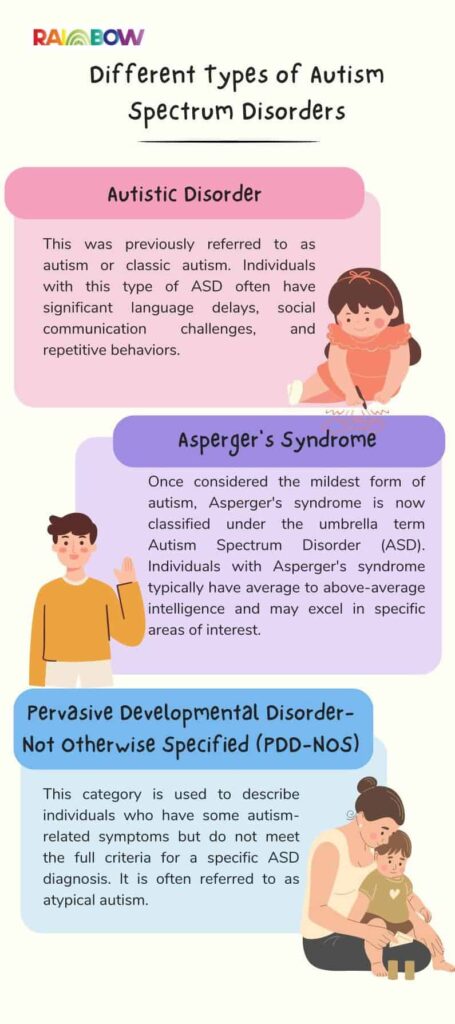Autism Spectrum Disorder (ASD) is a neurodevelopmental disorder that affects individuals in various ways. It is characterized by difficulties in social interaction, communication, and restricted and repetitive behaviors.
What is Autism Spectrum Disorder?
Autism Spectrum Disorder (ASD) is a complex developmental disorder that impacts a person’s ability to communicate, engage with others, and navigate the world around them. It is a lifelong condition that typically manifests in early childhood and continues into adulthood.
ASD is now recognized as a spectrum– it encompasses a wide range of symptoms and abilities. Each individual with ASD is unique and experiences the condition differently. Some individuals may require significant support in their daily lives, while others may have more independent lives.
Different Types of Autism Spectrum Disorders
Autism Spectrum Disorder comprises various types, each with its own characteristics and challenges. These types include:

It is important to note that the distinction between these types has evolved over time. Asperger’s syndrome, which was once considered a separate condition, is now classified under the broader umbrella of Autism Spectrum Disorder. The focus now lies on evaluating the individual’s unique profile of strengths and challenges rather than assigning a specific label.
Understanding the different types of Autism Spectrum Disorder helps to recognize the diverse range of experiences within the autism community. can create a more inclusive and supportive environment for individuals with ASD.

Asperger's Syndrome as the Mildest Form of Autism
Asperger’s Syndrome is often considered the mildest form of autism due to its characteristics, such as no significant language development delay, average to above-average intelligence, and a desire for social interaction, despite challenges in social skills.
Individuals with Asperger’s typically exhibit a strong vocabulary and cognitive abilities, and many can live independently, pursue higher education, and maintain employment. This relative independence and capacity for adaptive functioning, coupled with the absence of cognitive delays, contribute to the perception of Asperger’s Syndrome as a milder form of autism.
However, this does not negate the significant challenges those with Asperger’s face, particularly in social interaction and sensory processing. Asperger’s syndrome is characterized by significant difficulties in social interaction and nonverbal communication, along with restricted and repetitive patterns of behavior and interests. Individuals with Asperger’s syndrome often have normal to above-average intelligence and language development. However, they may struggle with understanding the nuances of social interactions, leading to difficulties in forming relationships and interpreting gestures and facial expressions.
Some key characteristics of Asperger’s syndrome include:
Social Interaction Challenges: Individuals with Asperger’s syndrome may find it challenging to engage in reciprocal social interactions. They may have difficulty understanding social cues, such as body language and facial expressions, and may struggle with maintaining eye contact or understanding social norms.
Communication Difficulties: People with Asperger’s syndrome may have a literal interpretation of language and may struggle with understanding sarcasm, irony, or abstract concepts. They may have a monotone or unusual speech pattern, and their conversations may focus on specific topics of interest.
Restricted and Repetitive Behaviors: Individuals with Asperger’s syndrome often exhibit repetitive behaviors and may have intense interests in specific topics. They may follow strict routines and become distressed by changes or transitions. These behaviors can provide comfort and a sense of control in their lives.
The Diagnostic and Statistical Manual of Mental Disorders (DSM-5) categorizes ASD into 3 levels, with Level 1 representing the mildest form:

It’s important to note that these levels are not rigid categories, but rather a continuum that reflects the varying degrees of support individuals with ASD may require. Asperger’s syndrome falls under Level 1 ASD, which indicates that individuals with this condition generally require less support compared to those at Levels 2 and 3. Although Asperger’s syndrome is considered the mildest form of autism, it is still a pervasive developmental disorder that presents unique characteristics and challenges.
In terms of gender distribution, Asperger’s syndrome is more commonly diagnosed in males than females, with a ratio of around 4:1. However, it is important to recognize that this gender bias may be influenced by various factors, including differences in the manifestation of symptoms and potential underdiagnosis in females.
Understanding the definition and characteristics of Asperger’s syndrome, as well as its prevalence provides valuable insights into this unique variation of autism spectrum disorder.

Living with Asperger's Syndrome
Living with Asperger’s Syndrome can present unique challenges and opportunities. Support and interventions play a crucial role in helping individuals with Asperger’s Syndrome navigate various aspects of their lives. In this section, we will explore the importance of support and interventions, building relationships and social skills, and adapting to changes and transitions.
Support and Interventions
Individuals with Asperger’s Syndrome often benefit from a supportive network that understands and accommodates their unique needs. Families, educators, and communities can provide valuable support by creating an inclusive and understanding environment. This may involve providing access to therapies, such as behavioral therapy, social skills training, speech therapy, and occupational therapy, which can help individuals develop coping strategies and improve social interactions.
Support groups can also offer a sense of community and understanding by connecting individuals with others who share similar experiences. These groups provide a platform for sharing challenges, seeking advice, and finding support in a non-judgmental environment. Online communities and forums can be particularly beneficial for those who may have limited access to in-person support groups.
Building Relationships and Social Skills
One of the key challenges for individuals with Asperger’s Syndrome is navigating social interactions. They may struggle with understanding non-verbal cues, maintaining eye contact, and interpreting social nuances. However, with appropriate interventions and support, individuals with Asperger’s Syndrome can develop effective social skills and build meaningful relationships.
Social skills training can help individuals with Asperger’s Syndrome learn and practice social cues, effective communication strategies, and appropriate behavior in various social settings. Role-playing exercises, group activities, and real-life scenarios can provide practical opportunities for individuals to enhance their social skills.
Additionally, therapy sessions can focus on developing self-awareness and understanding emotions, which can contribute to improved social interactions.
Adapting to Changes and Transitions
Individuals with Asperger’s Syndrome may find it challenging to adapt to changes in routines and transitions. They may exhibit a strong dislike for change and prefer predictable and structured environments. However, with support and gradual exposure, individuals with Asperger’s Syndrome can develop strategies to manage transitions effectively.
Visual schedules and calendars can provide a visual representation of upcoming changes and help individuals prepare for them. Breaking down larger transitions into smaller steps and providing clear instructions can also facilitate a smoother transition process.
Creating a supportive and understanding environment can significantly contribute to easing the challenges associated with changes and transitions. Educators, employers, and family members can play a vital role in offering guidance, flexibility, and patience as individuals with Asperger’s Syndrome adapt to new situations.
Diagnosis of Asperger's Syndrome
Diagnosing Asperger’s Syndrome can be a complex process, and it is often identified later in children, sometimes in their teenage years, due to the subtler symptoms compared to other forms of autism. The diagnosis is typically made by a team of professionals, including psychologists, psychiatrists, and developmental pediatricians. These experts assess the individual’s behavior, social skills, and communication patterns, using standardized criteria such as the Diagnostic and Statistical Manual of Mental Disorders (DSM-5).
To receive an Asperger’s Syndrome diagnosis, an individual must exhibit persistent difficulties in social interaction and repetitive patterns of behavior, interests, or activities. It is important to note that the diagnostic criteria have changed, and Asperger’s Syndrome is now considered part of the broader Autism Spectrum Disorder diagnosis.

Therapeutic Approaches for Asperger's Syndrome
Treating Asperger’s Syndrome involves a multidisciplinary approach tailored to the unique needs of each individual. Therapeutic interventions can help individuals with Asperger’s Syndrome develop coping strategies, improve social skills, and enhance overall quality of life. Some of the commonly used therapeutic approaches include:
Behavioral Therapy: This approach focuses on addressing challenging behaviors and teaching individuals appropriate social skills. Applied Behavioral Analysis (ABA) is often used to reinforce positive behaviors and reduce unwanted behaviors through structured interventions.
Social Skills Training: Social skills training aims to improve social interactions by teaching individuals with Asperger’s Syndrome how to recognize and interpret social cues, engage in conversations, and navigate social situations effectively.
Speech Therapy: Speech therapy can be beneficial for individuals with Asperger’s Syndrome who struggle with communication difficulties, such as understanding non-verbal cues, maintaining eye contact, or using appropriate tone and volume.
Occupational Therapy: Occupational therapy helps individuals develop practical skills necessary for daily living, such as self-care, organization, and sensory integration. It can also provide strategies to manage sensory sensitivities commonly experienced by individuals with Asperger’s Syndrome.
Supportive Strategies and Accommodations
Supportive strategies and accommodations play a crucial role in helping individuals with Asperger’s Syndrome thrive in various settings. These strategies may include:
- Structured Routines: Establishing structured routines can provide predictability and reduce anxiety for individuals with Asperger’s Syndrome. Clear schedules and visual aids can help them navigate their daily activities more effectively.
- Individualized Education Plans (IEPs): IEPs are tailored educational plans designed to meet the specific needs of individuals with Asperger’s Syndrome. These plans outline accommodations, modifications, and support services required for academic success.
- Support Groups: Support groups can provide a safe and understanding environment for individuals with Asperger’s Syndrome to connect with others facing similar challenges. These groups offer an opportunity to share experiences, learn from one another, and develop social support networks.
By combining diagnostic assessments, therapeutic interventions, and supportive strategies, individuals with Asperger’s Syndrome can receive the necessary support to navigate the challenges they may face. Understanding and embracing the unique strengths and perspectives of individuals with Asperger’s Syndrome is vital in promoting their overall well-being and helping them lead fulfilling lives.

